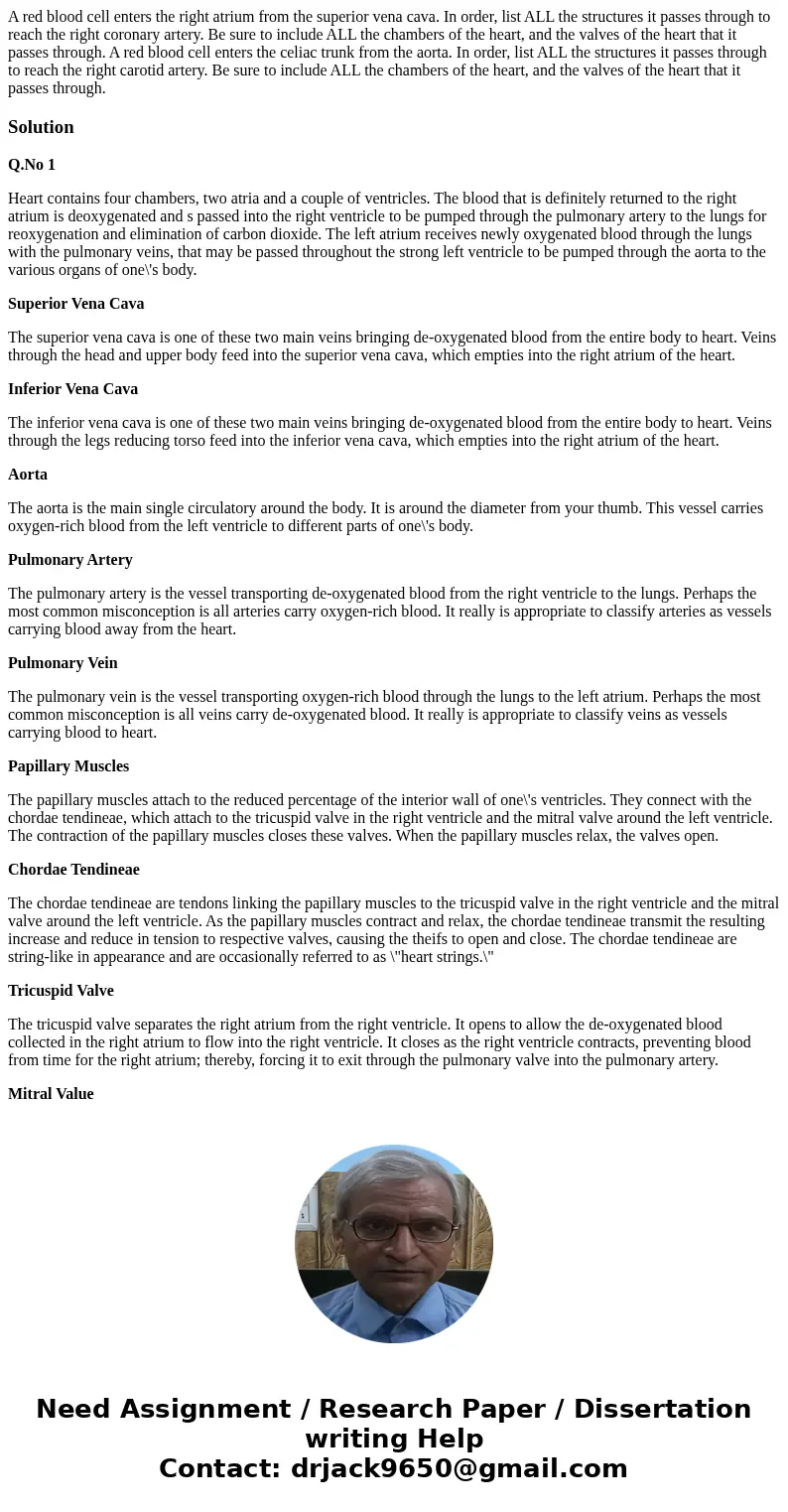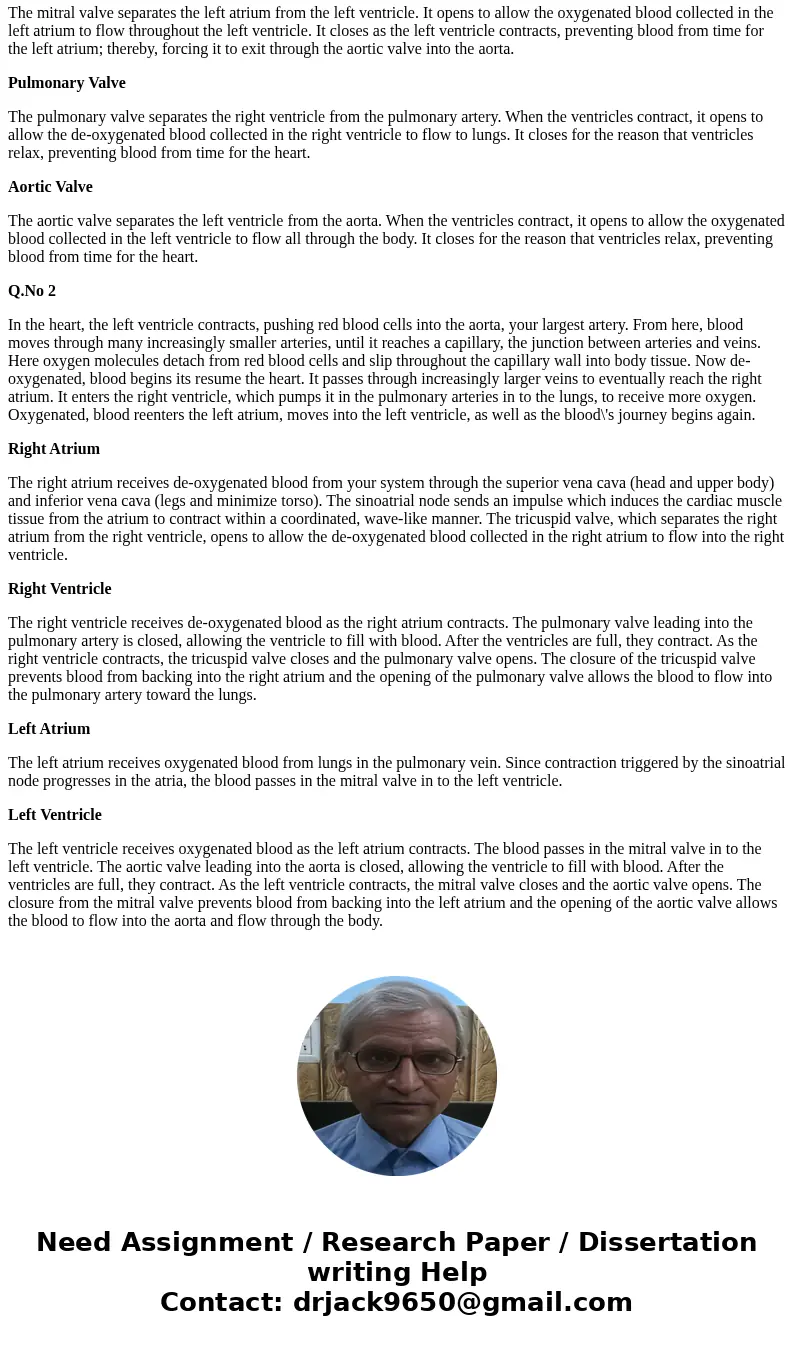A red blood cell enters the right atrium from the superior v
Solution
Q.No 1
Heart contains four chambers, two atria and a couple of ventricles. The blood that is definitely returned to the right atrium is deoxygenated and s passed into the right ventricle to be pumped through the pulmonary artery to the lungs for reoxygenation and elimination of carbon dioxide. The left atrium receives newly oxygenated blood through the lungs with the pulmonary veins, that may be passed throughout the strong left ventricle to be pumped through the aorta to the various organs of one\'s body.
Superior Vena Cava
The superior vena cava is one of these two main veins bringing de-oxygenated blood from the entire body to heart. Veins through the head and upper body feed into the superior vena cava, which empties into the right atrium of the heart.
Inferior Vena Cava
The inferior vena cava is one of these two main veins bringing de-oxygenated blood from the entire body to heart. Veins through the legs reducing torso feed into the inferior vena cava, which empties into the right atrium of the heart.
Aorta
The aorta is the main single circulatory around the body. It is around the diameter from your thumb. This vessel carries oxygen-rich blood from the left ventricle to different parts of one\'s body.
Pulmonary Artery
The pulmonary artery is the vessel transporting de-oxygenated blood from the right ventricle to the lungs. Perhaps the most common misconception is all arteries carry oxygen-rich blood. It really is appropriate to classify arteries as vessels carrying blood away from the heart.
Pulmonary Vein
The pulmonary vein is the vessel transporting oxygen-rich blood through the lungs to the left atrium. Perhaps the most common misconception is all veins carry de-oxygenated blood. It really is appropriate to classify veins as vessels carrying blood to heart.
Papillary Muscles
The papillary muscles attach to the reduced percentage of the interior wall of one\'s ventricles. They connect with the chordae tendineae, which attach to the tricuspid valve in the right ventricle and the mitral valve around the left ventricle. The contraction of the papillary muscles closes these valves. When the papillary muscles relax, the valves open.
Chordae Tendineae
The chordae tendineae are tendons linking the papillary muscles to the tricuspid valve in the right ventricle and the mitral valve around the left ventricle. As the papillary muscles contract and relax, the chordae tendineae transmit the resulting increase and reduce in tension to respective valves, causing the theifs to open and close. The chordae tendineae are string-like in appearance and are occasionally referred to as \"heart strings.\"
Tricuspid Valve
The tricuspid valve separates the right atrium from the right ventricle. It opens to allow the de-oxygenated blood collected in the right atrium to flow into the right ventricle. It closes as the right ventricle contracts, preventing blood from time for the right atrium; thereby, forcing it to exit through the pulmonary valve into the pulmonary artery.
Mitral Value
The mitral valve separates the left atrium from the left ventricle. It opens to allow the oxygenated blood collected in the left atrium to flow throughout the left ventricle. It closes as the left ventricle contracts, preventing blood from time for the left atrium; thereby, forcing it to exit through the aortic valve into the aorta.
Pulmonary Valve
The pulmonary valve separates the right ventricle from the pulmonary artery. When the ventricles contract, it opens to allow the de-oxygenated blood collected in the right ventricle to flow to lungs. It closes for the reason that ventricles relax, preventing blood from time for the heart.
Aortic Valve
The aortic valve separates the left ventricle from the aorta. When the ventricles contract, it opens to allow the oxygenated blood collected in the left ventricle to flow all through the body. It closes for the reason that ventricles relax, preventing blood from time for the heart.
Q.No 2
In the heart, the left ventricle contracts, pushing red blood cells into the aorta, your largest artery. From here, blood moves through many increasingly smaller arteries, until it reaches a capillary, the junction between arteries and veins. Here oxygen molecules detach from red blood cells and slip throughout the capillary wall into body tissue. Now de-oxygenated, blood begins its resume the heart. It passes through increasingly larger veins to eventually reach the right atrium. It enters the right ventricle, which pumps it in the pulmonary arteries in to the lungs, to receive more oxygen. Oxygenated, blood reenters the left atrium, moves into the left ventricle, as well as the blood\'s journey begins again.
Right Atrium
The right atrium receives de-oxygenated blood from your system through the superior vena cava (head and upper body) and inferior vena cava (legs and minimize torso). The sinoatrial node sends an impulse which induces the cardiac muscle tissue from the atrium to contract within a coordinated, wave-like manner. The tricuspid valve, which separates the right atrium from the right ventricle, opens to allow the de-oxygenated blood collected in the right atrium to flow into the right ventricle.
Right Ventricle
The right ventricle receives de-oxygenated blood as the right atrium contracts. The pulmonary valve leading into the pulmonary artery is closed, allowing the ventricle to fill with blood. After the ventricles are full, they contract. As the right ventricle contracts, the tricuspid valve closes and the pulmonary valve opens. The closure of the tricuspid valve prevents blood from backing into the right atrium and the opening of the pulmonary valve allows the blood to flow into the pulmonary artery toward the lungs.
Left Atrium
The left atrium receives oxygenated blood from lungs in the pulmonary vein. Since contraction triggered by the sinoatrial node progresses in the atria, the blood passes in the mitral valve in to the left ventricle.
Left Ventricle
The left ventricle receives oxygenated blood as the left atrium contracts. The blood passes in the mitral valve in to the left ventricle. The aortic valve leading into the aorta is closed, allowing the ventricle to fill with blood. After the ventricles are full, they contract. As the left ventricle contracts, the mitral valve closes and the aortic valve opens. The closure from the mitral valve prevents blood from backing into the left atrium and the opening of the aortic valve allows the blood to flow into the aorta and flow through the body.


 Homework Sourse
Homework Sourse